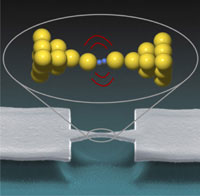| Posted: January 21, 2009 |
Nanotechnology allows building the smallest possible switches |
|
(Nanowerk News) The smallest mechanical switch plus an electronic switch of a type never seen before. That’s how physicist Marius Trouwborst sums up the results of his PhD research on electric current through atoms and molecules. ‘The ultimate aim of nanotechnology is to use molecules for electronics’, he says. ‘That aim has now come a step closer.’
|
|
The enormous progress in information technology is mainly related to the fact that the electronic parts in computers are getting smaller and smaller. And smaller automatically means quicker and cheaper. In the past forty years, the number of transistors in a computer chip has doubled every two years. However, in ten years from now we will reach a physical limit, estimates Trouwborst. At this limit, the basic principles of the transistor do not longer work properly.
|
 |
| Hydrogen switch. Below: picture of a gold wire as used in the research, taken with an electron microscope. Above: a sketch of a hydrogen molecule contacted between two gold wires.
|
|
Fundamental research
|
|
If we want to continue with making faster computers, new methods have to be discovered. One possibility is to use atoms and molecules. Trouwborst’s fundamental research on electron transport through individual atoms and molecules fits into this hunt.
|
|
Miniscule
|
|
During the research, Trouwborst developed a new method to organize gold atoms in such a way that a very tiny mechanical switch could be made with them: only a single gold atom forms the contact. In addition, Trouwborst constructed a new type of electronic switch of the same miniscule size.
|
|
Chewing gum
|
|
The method works with a so-called break junction. First, a gold wire is fixed onto a strip of flexible plastic. By now carefully bending the strip, the gold wire slowly stretches out, just like chewing gum. Just before it breaks, the wire has a diameter of only one gold atom. Extremely careful further bending (at the nanoscale) moves the ends a tiny distance away from each other. Although the wires are now separated, the fracture is is not definitive. As soon as it is very, very carefully bent back into position the ends fuse together again.
|
|
Contact of a single atom
|
|
Trouwborst repeated this bending back and forth for many times, in a very controlled way. Every time the wire breaks, the atoms in the two ends get organized in a different way. Trouwborst discovered that this reorganization gradually becomes more regular. Finally, the points look like carefully stacked pyramids of billiard balls with a single atom at the apex. ‘By moving the two ends back and forth by a distance of 0.1 nanometre, the switch can be turned on and off’, says Trouwborst.
|
|
Captured molecule
|
|
Moreover, the system can also be used to ‘catch’ a molecule between the ends. That is useful for studying the electronic characteristics of that molecule. When an electrical voltage is set over the ends, all the electron transport goes through that single molecule in the middle.
Trouwborst used hydrogen molecules for his research. When increasing the voltage, the hydrogen molecule starts to vibrate between the ends of the gold threads. Trouwborst discovered that the resistance then suddenly changes, it jumps down. ‘You can simply turn the system on or off by making the molecules vibrate or not’, says Trouwborst. ‘This type of switch has never been shown before.’
|
|
Unknown cause
|
|
Although related to the vibrating molecules, the exact cause of this switching behaviour is still unknown. Trouwborst suspects that is has something to do with a phase transition. More research is needed before the switches can actually be used. However, ‘what is clear’, says Trouwborst, ‘is that it provides new insight on the road to using molecules as functional building elements in the electronics of the future.’
|

